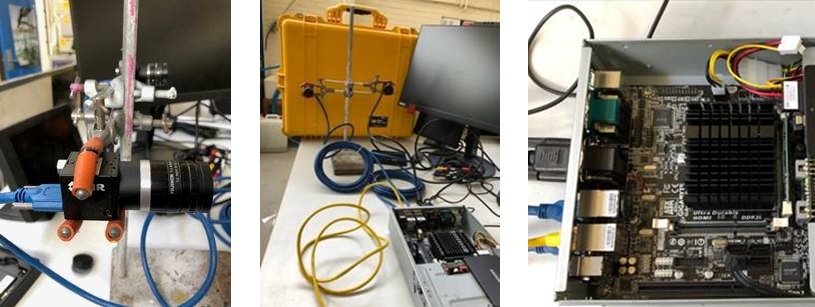Cameras on the Wolf Rock lighthouse, 8 miles off Land’s End, are now set to capture storm wave activity around the tower. Earlier this summer the STORMLAMP project commissioned marine instrumentation experts Mr Peter Ganderton and Dr Alex Nimmo-Smith of the School of Biological and Marine Sciences at the University of Plymouth to develop a low-power and remote-controlled stereo imaging system. They received guidance on the camera set-up from Dr Alvise Benetazzo from the Institute of Marine Sciences, ISMAR – CNR in Venice who has recently designed a similar system for La Jument lighthouse in Brittany, and others on fixed platforms and moving vessels.
The technical bit…
The system comprises 2 synchronised cameras and a mini computer for logging data, with bespoke software for data logging and control. To provide protection from the harsh environment the camera housings are rated IP66 (water protection from powerful jets) and all the control hardware is housed in an industry standard waterproof/crushproof case. The system is controlled via a 4G network that links to the Cape Cornwall Coastwatch station and then to the University of Plymouth. Two cameras with overlapping fields of view permit, via a complex algorithm, the extraction of quantitative wave data to be used in wave-structure interaction analysis of the lighthouse.

Great expectations
When storm waves crash onto the lighthouse they cause it to vibrate; these are sometimes discernible to personnel on station. Using a structural monitoring system already installed on the lighthouse as part of the STORMLAMP project, the vibration data gets sent back to the University of Exeter. The data is combined with information about the characteristics of the structure obtained from earlier field vibration testing. This linking of information allows the determination of the wave load that must have caused a particular vibration. Results from this so-called inverse analysis will in the future be combined with the camera system to provide the full story: the size of the wave as it comes crashing over the rocks, the wave load as it pounds against the tower and then the resulting vibration. It’s rare to get such detailed information at such a challenging site, but that’s what you get when you bring the very best people together on an engineering project. Now we just wait for the Atlantic storms to roll in.

has to your comments above 1972 i was in charge of landing the helliepad and men at the wolf i would be interested to no the condition after all these years don smeeton Skipper THV STRATHCLYDE
Hello Don. The helideck is doing rather well for a steel structure that has been for 4 decades in the middle of the hostile sea. There is some minor corrosion but Trinity House has a robust maintenance plan. We are currently analysing what will be the structural condition of the helideck after very strong wave impacts that are able to make the masonry tower rock. We believe that Wolf Rock has not experienced such intense shakes yet and predicting the structural behaviour is the demanding part of this research.
Hello. Will broadcast video with waves be shown to users? Can we see the wave record somewhere?
Hello Tanya. The video files are huge, but we’ll certainly consider how we share some of the interesting data. We are saving the disk storage space until we have big storms hopefully later this autumn/winter.